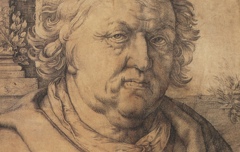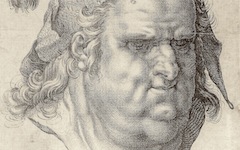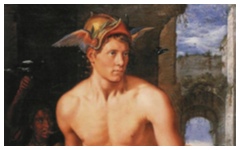Goltzius’ Apollo (1588)
Hendrik Goltzius was said to be serious and thoughtful, a man "who does not concern himself at all with worldly cares and everyday chatter, but someone who, out of an all-surpassing love of art, is happy to be silent and alone with a quiet soul, because art possesses him utterly."1 Apprenticed to an engraver and ethicist whose unorthodox Catholicism appealed to tolerance and reason as a remedy for religious fanaticism, Goltzius appears to have acquired at an early age a philosophical, all-embracing approach to life in keeping with the essential spirit of the Inner Tradition. Described as witty and inventive by both contemporaries and modern scholars, we have in fact been provided with very little evidence of either. Reports of a practical joke or two and the discovery that in a few engravings he imitated another artist's style is all we have.2 There has to be more.
Goltzius was a master engraver and Mannerist whose dazzling technique so overwhelms his viewers that they often miss his meaning in thinking his style is all. This particular engraving is so crammed with detail that it deserves extended analysis. Yet, to be brief, I will reveal only certain elements that have never been seen (as always, except by artists, of course). Their implications will change not only the meaning of this image but of Goltzius' art in general.
Click next thumbnail to continue
Unnoted in Apollo's hip facing us, closer to the surface than any other part of his body, is a bearded and mustachioed "face". If that were all, the claim would remain unproven and possibly meaningless. Yet this is not just a face. It's a specific face.
Click next thumbnail to continue

Goltzius, Apollo (1588)
Inset left: Enlarged detail of Goltzius' Apollo
Inset right: Goltzius' Portrait of Jan Goltz II (1579), a detail. Metalpoint on tablet. Den Kongelige Koberstiksamling, Copenhagen.
Click image to enlarge.
It is the artist's father, Jan Goltz II, a not very successful painter of stained glass. In comparing Goltzius' portrait of him to the muscles in the hip, you should be able to recognize similarity in the overall shape, proportions and expression.
Click next thumbnail to continue

Top left and right: Details of Goltzius' Apollo and Portrait of Jan Goltz II
Lower left and right: Diagrams of details above
Click image to enlarge.
A closer look reveals numerous points of similarity as outlined in the diagrams below. From the curving contour of the torso (and face) on the far right to the sinuous line of the moustache descending on the left there are too many correspondences for coincidence. This would be remarkable enough if the reference were to any of his portraits; that it is his father's, confirms it.
Click next thumbnail to continue
A Goltzius' specialist has noted that Apollo's pose derives from Lucas van Leyden's engraving of The Standard-Bearer (c.1510), an image I revealed only yesterday also includes a hidden "face".3 Goltzius associated Apollo's figure, through its pose, with Lucas' own. The divine Apollo, descended from Lucas, represents artistic perfection in Goltzius' mind, an observation confirmed by the artist's monogram beneath his foot. Emerging reincarnated out of his father's "head", Goltzius takes on the great master's mantle from Lucas whose mind he seems to have felt he shared. The oval tondo and the circular tunnel within, Apollo visible on his chariot in the distance, seems to represent Goltzius' visual system (behind his eye) just as Apollo's pointing finger to the right represents his craft. Finally, the twisting, rock-like clouds now seem to represent the soft crenellations of the cerebral cortex, something more commonly depicted in art than many realize.
More Works by Goltzius
Think about who you are if, for instance, you are not yourself

Goltzius’ Portrait of Jan Govertsz van der Aar as St. Luke (1614)
Notes:
1. Paraphrase of Karl van Mander, Levens, fols. 286r-286v. cited in Hendrick Goltzius: Drawings, Prints and Paintings (New York: Metropolitan Museum of Art) 2003, p. 13
2. Huigen Leeflang, "The Life of Hendrick Goltzius" in Hendrick Goltzius, op. cit., pp. 14-16
3. Orenstein, "Finally Spranger: Prints and Print Designs, 1586-90" in Hendrick Goltzius, op. cit., pp. 94-6
Original Publication Date on EPPH: 01 Mar 2013. | Updated: 0. © Simon Abrahams. Articles on this site are the copyright of Simon Abrahams. To use copyrighted material in print or other media for purposes beyond 'fair use', you must obtain permission from the copyright owner. Websites may link to this page without permission (please do) but may not reproduce the material on their own site without crediting Simon Abrahams and EPPH.




